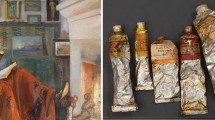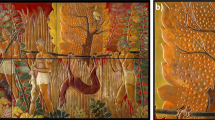Abstract
Fourier transform infrared spectroscopy and imaging coupled to optical microscopy, scanning electron microscopy coupled to energy dispersive x-ray spectroscopy and high-performance liquid chromatography (HPLC) coupled to diode-array detection are used to investigate two samples removed from a painted decoration of a burial kline and a textile fragment, both found in Koru tumulus (fifth century BCE) in Daskyleion. Tyrian purple and kaolinite were identified in both samples, thus suggesting that the aluminosilicate compound had an important role in the applied painting and dyeing processes. The textile fragment is composed of undyed cotton and silk yarns dyed with the molluskan dye. The relative compositions of the molluskan materials used in the two archaeological objects are similar and comparable with the corresponding composition measured for a purple sample originated from Murex trunculus mollusks according to the HPLC results. This result is supported by principal component analysis (PCA) which, furthermore, takes into account the relative compositions of the extracts of the three Mediterranean mollusks, published in previous reports.











Similar content being viewed by others
References
Andreotti A, Carmignani A, Colombini MP, Modugno F (2006) Characterization of paint organic materials in wall decorations of Macedonian tombs. In: Brecoulaki H (ed) La peinture funeraire de macedoine, emplois et fonctions de la couleur IVe-IIe s av J-C Vol ΙΙ: planches & tableaux, Appendix IV. National Hellenic Research Foundation, Athens
Cardon D (2007) Natural dyes—sources, tradition, technology and science. Archetype Publications Ltd., London
Clark RJH, Cooksey CJ (1999) Monobromoindigos: a new general synthesis, the characterization of all four isomers and an investigation into the purple colour of 6,6′-dibromoindigo. New J Chem 323–328
Colombini MP, Carmignani A, Modugno F, Frezzato F, Olchini A, Brecoulaki H, Vassilopoulou V, Karkanas P (2004) Integrated analytical techniques for the study of ancient Greek polychromy. Talanta 63:839–48
Cook JG (1993) Handbook of textile fibres I. Natural fibres. Merrow Publishing Co, Wiltshire
Derrick MR, Stulik D, Landry JM (1999) Infrared spectroscopy in conservation science, scientific tools for conservation. The Getty conservation institute, Los Angeles
Friedländer P (1909) Den farbstoff des antiken purpurs aus Murex brandaris. Ber Dtsch Chem Ges 42:765–770
Graves PH, Saville BP (1995) Microscopy of textile fibres. Bios Scientific Publishers, Oxford
İren K (2012) Dascyleum. A multicultural society in the shadow of Persia. Curr World Archaeol 54:49–51
İren K (2013) Daskyleion. In: Bagnall RS, Brodersen K, Champion CB, Erskine A, Huebner SR (eds) The encyclopedia of ancient history, 1st ed, Wiley-Blackwell, pp1930–31
Kakoulli I (2002) Late Classical and Hellenistic painting techniques and materials: a review of the technical literature. Rev Conserv 3:56–67
Karapanagiotis I, Sotiropoulou S, Chryssikopoulou E, Magiatis Pr, Andrikopoulos KS, Chryssoulakis Y (2004) Investigation of Tyrian purple occurring in historical wall paintings of Thera. Dyes Hist Archaeol Proceedings of the 23rd DHA meeting, Montpellier, in press
Karapanagiotis I, de Villemereuil V, Magiatis P, Polychronopoulos P, Vougogiannopoulou K, Skaltsounis AL (2006) Identification of the coloring constituents of four natural indigoid dyes. J Liq Chromatogr Relat Technol 29:1491–502
Karapanagiotis I, Mantzouris D, Cooksey C, Mubarak MS, Tsiamyrtzis P (2013) An improved HPLC method coupled to PCA for the identification of Tyrian purple in archaeological and historical samples. Microchem J 110:70–80
Karydas AG (2006) In situ XRF analyses of wall-painting pigments on ancient funeral Macedonian monument. In: Brecoulaki H (ed) La peinture funeraire de macedoine, emplois et fonctions de la couleur IVe-IIe s av J-C vol ΙΙ: planches & tableaux, Appendix IV. National Hellenic Research Foundation, Athens
Kavkler K, Gunde-Cimerman N, Zalar P, Demsar A (2011) FTIR spectroscopy of biodegraded historical textiles. Polym Degrad Stabil 96:574–80
Koren ZC (1995) High-performance liquid chromatographic analysis of an ancient Tyrian purple dyeing vat from Israel. Isr J Chem 35:117–24
Koren ZC (2008) Archaeo-chemical analysis of royal purple on a Darius I stone jar. Microchim Acta 162:381–92
Luniak B (1953) The identification of textile fibers. Sir Isaac Pitman & Sons, London
Mantzouris D, Karapanagiotis I (2014) Identification of indirubin and monobromoindirubins in Murex brandaris. Dyes Pigm 104:194–96
Mantzouris D, Karapanagiotis I, Valianou L, Panayiotou C (2011) HPLC-DAD-MS analysis of dyes identified in textiles from Mount Athos. Anal Bioanal Chem 399:3065–79
Maravelaki-Kalaitzaki P, Kallithrakas-Kontos N (2003) Pigment and terracotta analyses of Hellenistic figurines in Crete. Anal Chim Acta 497:209–25
Margariti C, Protopapas S, Allen N, Vishnyakov V (2013) Identification of purple dye from molluscs on an excavated textile by non-destructive analytical techniques. Dyes Pigm 96:774–80
McGovern PE, Michel RH (1990) Royal purple dye: the chemical reconstruction of the ancient Mediterranean industry. Accounts Chem Res 23:152–58
Michel RH, Lazar J, McGovern PE (1992a) The chemical composition of the indigoid dyes derived from the hypobranchial glandular secretions of Murex mollusks. J Soc Dyers Colour 108:145–50
Michel RH, Lazar J, McGovern PE (1992b) Indigoid dyes in Peruvian and Coptic textiles of the University Museum of Archaeology and Anthropology. Archeomaterials 6:69–83
Nour WMN, Awad HM (2008) Effect of MgO on phase formation and mullite morphology of different Egyptian clays. J Aust Ceram Soc 44:27–37
Nowik W, Marcinowska R, Kusyk K, Cardon D, Trojanowicz M (2011) High performance liquid chromatography of slightly soluble brominated indigoids from Tyrian purple. J Chromatogr A 1218:1244–52
Serrano A, Sousa MM, Hallett J, Lopes JA, Oliveira MC (2011) Analysis of natural red dyes (cochineal) in textiles of historical importance using HPLC and multivariate data analysis. Anal Bioanal Chem 401:735–43
Sotiropoulou S, Karapanagiotis I (2006) Conchylian purple investigation in prehistoric wall paintings of the Aegean area. In: Meijer L, Guyard N, Skaltsounis AL, Eisenbrand G (eds) Indirubin the red shade of indigo. Life in Progress Editions. Roscoff, pp 71–78
Sousa MM, Melo MJ, Parola AJ, de Melo JSS, Catarino F, Pina F, Cook FEM, Simmonds MSJ, Lopes JA (2008) Flavylium chromophores as species markers for dragon’s blood resins from Dracaena and Daemonorops trees. J Chromatogr A 1209:153–61
Westenholz JG, Stolper MW (2002) A stone jar with inscriptions of Darius I in four languages. Arta 005:1–13
Wouters J (1992) A new method for the analysis of blue and purple dyes in textiles. Dyes Hist Archaeol 10:17–21
Wouters J (2001) The dye of Rubia peregrina—preliminary investigations. Dyes Hist Archaeol 16(17):145–57
Wouters J, Verhecken A (1989) The coccid insect dyes: HPLC and computerized diode-array analysis of dyed yarns. Stud Conserv 34:189–200
XiaoMei Z, Paul W (2010) Using FTIR spectroscopy to detect sericin on historic silk. Sci China Chem 53:626–31
Acknowledgement
The authors would like to thank Dimosthenis Kechagias for his help in the identification of cotton.
Author information
Authors and Affiliations
Corresponding author
Rights and permissions
About this article
Cite this article
Papliaka, Z.E., Konstanta, A., Karapanagiotis, I. et al. FTIR imaging and HPLC reveal ancient painting and dyeing techniques of molluskan purple. Archaeol Anthropol Sci 9, 197–208 (2017). https://doi.org/10.1007/s12520-015-0270-3
Received:
Accepted:
Published:
Issue Date:
DOI: https://doi.org/10.1007/s12520-015-0270-3




